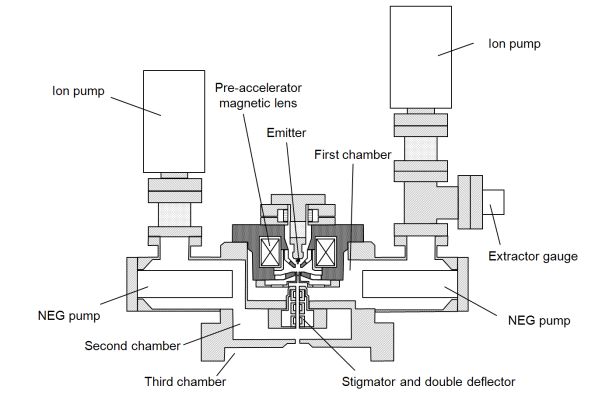IT-1-O-1664 Magnetic-Field-Superimposed Cold Field Emission Gun for 1.2-MV Transmission Electron Microscope
A magnetic-field-superimposed cold field emission gun (M-FEG) was developed for a 1.2-MV transmission electron microscope (TEM)[1]. This microscope is intended to have a point resolution of 40 pm and to take atomic-scale three-dimensional images by electron holography.
Figure 1 shows the cross section of the developed M-FEG. The gun is designed to have a high brightness and stable emission current. The gun is equipped with a pre-accelerator magnetic lens placed close to the emitter [2]. The superimposed magnetic field causes the emitted electrons to converge so that the aberration-caused blurring with subsequent electrostatic lenses is minimized. As a result, the inherent high brightness of the cold field emitter can be obtained. The chambers of the gun are differentially evacuated with three non-evaporative getter (NEG) pumps and four ion pumps. The pressure of the first chamber, where the emitter is placed, was 3×10-10 Pa. This small pressure stabilizes time variations of the emission current [3].
Figure 2 shows the measured time variations of the probe and total currents. After performing flashing of the emitter, the initial probe current of 1 nA was obtained at the total current of 1 µA. The probe current stayed almost constant for more than 10 hours during the initial period of the measurement. The 90% decrease time, at which the current falls to 90% of the initial value, was prolonged to 900 min in comparison with 3 min in a previous gun at 5×10-8 Pa [4]. The variation in the probe current over the course of the initial 8 hours was 5.2%.
Another advantage of the pressure reduction is the increase in probe current. It increased two times higher than that of the conventional field emission gun operating at 10-8 Pa. This reason can be explained by the fact that the clean emitter surface has higher probe current density than the adsorbed surface. The gun provided large probe currents ranging from 1 to 170 nA for total currents ranging from 1 to 300 µA.
The resulting current characteristics ensure that the 1.2-MV TEM will have fine resolution with a high S/N ratio. The illumination system of the microscope is discussed by Kawasaki in this conference.
[1] K. Kasuya et al., submitted to J. Vac. Sci. Technol. B.
[2] M. Troyon, Optik 57, 401 (1980).
[3] K. Kasuya et al., J. Vac. Sci. Technol. B 28, L55 (2010).
[4] T. Kawasaki et al., J. Elec. Microsc. 49, 711 (2000).
This research was supported by the Japan Society for the Promotion of Science through the FIRST Program, initiated by the Council for Science and Technology Policy.

